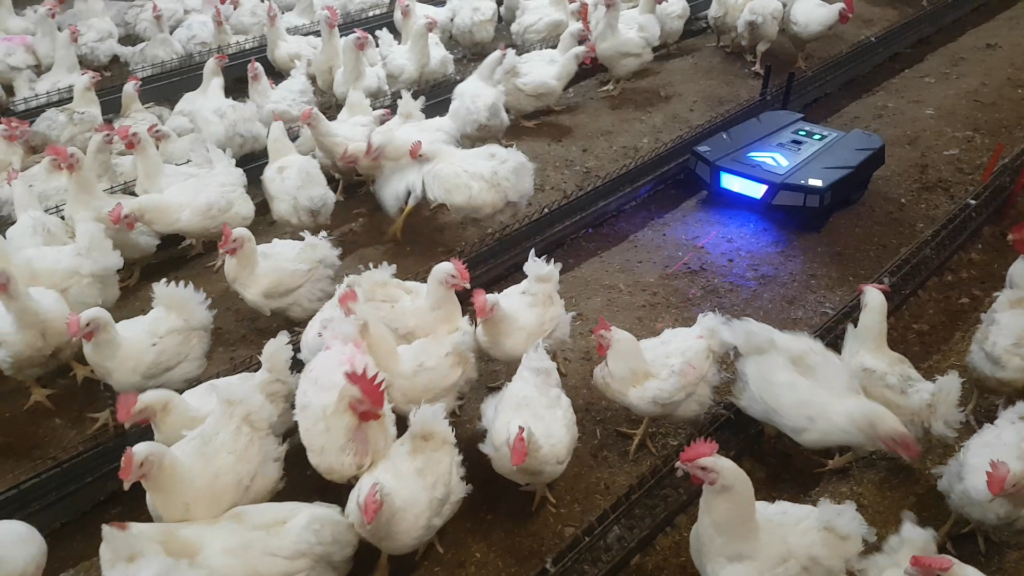
SAVE THE DATE – IPPE 2023 – Atlanta
We invite you to the IPPE tradeshow from January 24…


Broiler Breeders
The Hubbard Applied Innovation team asked Tibot to conduct a study on the impact of its Spoutnic robot on ticking behavior and poultry fertility. After more than 65 hours of observations, the first conclusions are drawn. In just 2 consecutive weeks of end-of-batch use, the ticking activity increased by 30% with an improving effect of up to 5 points in the fertility rate.
During the studies conducted by the Applied Innovation Team, Hubbard assessed the impact of the Spoutnic robot on mating and fertility of male and female breeders, without intervening environmental or external factors. Tests were conducted with the robot on two flocks of broiler breeders aged 48 weeks and 55 weeks, respectively.
In order to establish the rate of mating activity during the week preceding the robot installation, an initial observation was conducted over a 3-hour period before the lights were turned off. Each mating attempt was rated according to a specific scoring scale consisting of three main categories: successful mating, unsuccessful mating due to a halt in the male’s activity, unsuccessful mating due to female refusal. Once the robot was installed in the building – operating for eight hours before lights are turned off – the same observer studied the mating activity. The observation was conducted over a two-week period to reduce the impact age could have on results.
Thanks to the TIBOT robot, we observed a 30% increase in mating attempts, as shown in the two diagrams below.


“The presence of the robot in the building helps maintain hen and rooster activity, resulting in an increase in mating attempts, especially during the last two hours before lights are turned off. This is particularly attractive as literature shows that hens require more frequent mating after they have reached 45 weeks of age.” Mathieu Lardière – Technical Manager Europe, Middle East & Africa region / Applied Innovation Team Manager – Hubbard
In addition to mating observations, the study protocol also included fertility tracking in an aim to establish a correlation between mating activity and flock’s fertility.
Following each observation of mating activity, a sample of 120 eggs were placed in incubation in a 480-egg hatching incubator (see photo opposite) to assess the percentage of clear eggs (infertile or early dead embryos). This reduced any factors linked to transportation or storing that may have affected the study.
The study showed a decrease in fertility during the first week of the robot’s presence. Presumably, birds over 45 weeks of age require a period of adaptation to the robot as they had never seen one before. “This reaction would most likely have been avoided with animals already accustomed to robots at the start of the flock ”, adds Yanne Courcoux, CEO and Co-founder of TIBOT Technologies.
Just two weeks after the robot was introduced into the poultry shed, fertility rates stabilised or increased to offset the natural loss of the flock’s fertility. Moreover, the Hubbard team observed a five-point increase in the number of fertilised eggs in the flock of birds over 55 weeks.
“During these various trials, more than 4,000 mating attempts were recorded. The findings demonstrated a high correlation between the number of mating attempts and flock’s fertility. Spoutnic helped us keep our birds active during the last hours of the day when human presence is limited”, observes Mathieu Lardière.
As a compact robot, Spoutnic moves randomly and independently throughout the scratching area. By circulating freely throughout the flock, it gets the birds to mingle and stimulates their natural behaviour. The robot gently stirs the birds and thus prevents lethargy and crowding. Subsequently, we observed a boost in the roosters’ libido (especially in ageing subjects) and decreases in refusal rates of females who were more apt for mating.
The Spoutnic robot solution reduces inertia, encourages the birds’ activity and increases the number of clean eggs laid in the nests.